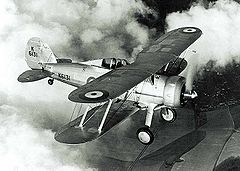- CC Gear synchronization
-
The Constantinesco Fire Control Timing Gear is an interrupter gear, a device used on military aircraft and warships in order to allow them to target opponents without damaging themselves.
Contents
Use
 The last British Plane using CC Gear was the Gloster Gladiator
The last British Plane using CC Gear was the Gloster Gladiator
By March (1917), the British had introduced a new form of synchronizer based on hydraulics rather than mechanical linkages. Developed by Romanian inventor George Constantinescu, the Constantinescu synchronization gear (or "CC" gear) used impulses transmitted by a column of liquid to enable the gun trigger. This innovation was more reliable than earlier methods and also provided a faster rate of fire close to that of a normal machine gun and independent of engine revolutions. The CC gear remained standard on British fighters until the start of World War II.
[1] The Patent for the complete specification was granted on 17 July 1919. At least 50,000 units were produced.[2]
-
[2]It appears that the Germans never succeeded in copying the C.C. Gear and according to George Constantinesco this was because they did not understand it, believing it to be a conventional hydraulic system, which is just as well! When it was disclosed to the French they also rejected it for the same reason. The British and the Americans also thought at first that the gear was just an ingenious hydraulic system which worked better than anything else available and that was good enough for them. However, when the time came for manufacturers and the Air Services to prepare installation, operation and maintenance manuals for the use of pilots and mechanics, the operation of the gear by the generation of pulses, or wave transmission, was explained. The gear was in fact an application of George Constantinesco's Theory of sonics, which remained secret until after the war. Thus, in accordance with that theory, the gear was operated by a hydrosonic transmission.
Description
The gear is made of the following units :
The Generator
THE GENERATOR consists of a shaft and cam, I, running in bearings 5 and 6, held in the casing 2 and actuating the piston 4, in the cylinder 3, which is screwed into the casing. An oil retaining cover 7, is provided and holes are drilled in the bearings to facilitate lubrication.
Erection
THE GENERATOR. The cylinder 3, must be arranged to be pointing as nearly vertically downwards as convenient, so that the pipe line can be led away by easy bends and without any chance of an air lock.
The lubricating oil filling hole and plug 8, must be placed so that oil can be conveniently filled through it before each flight. The oil retaining cover 7, can be moved round and rebolted in a convenient position ; the generator must be seven-eighths filled with pure engine lubricating oil.
PART LIST Name No
- Cam 1
- Body of Generator 2
- Cylinder 3
- Piston 4
- End Cover with Stuffing Box 5
- End Cover Speedometer side 6
- Oil Retaining Cover 7
- Plug for do. 8
- Union Nut 9
- Tail Piece 10
- Gland Nut 11
- Gland Ring 12
- Coupling Flange 13
UPKEEP
THE GENERATOR should always be seven-eighths full of oil, and the piston 4 should be inspected regularly, and if in a defective condition replaced by a new one.
The Trigger Motor
The Reservoir with Bowden Control
The Pipe Line
Notes
- ^ http://www.aerospaceweb.org/question/weapons/q0303.shtml
- ^ a b http://fluid.power.net/fpn/const/const004.html
- ^ http://www.archive.org/stream/handbookofccgear00greaiala/handbookofccgear00greaiala_djvu.txt
- ^ http://www.flightglobal.com/pdfarchive/view/1936/1936%20-%202041.html
- ^ http://ia340936.us.archive.org/1/items/handbookofccgear00greaiala/handbookofccgear00greaiala.pdf
Categories: -
Wikimedia Foundation. 2010.


